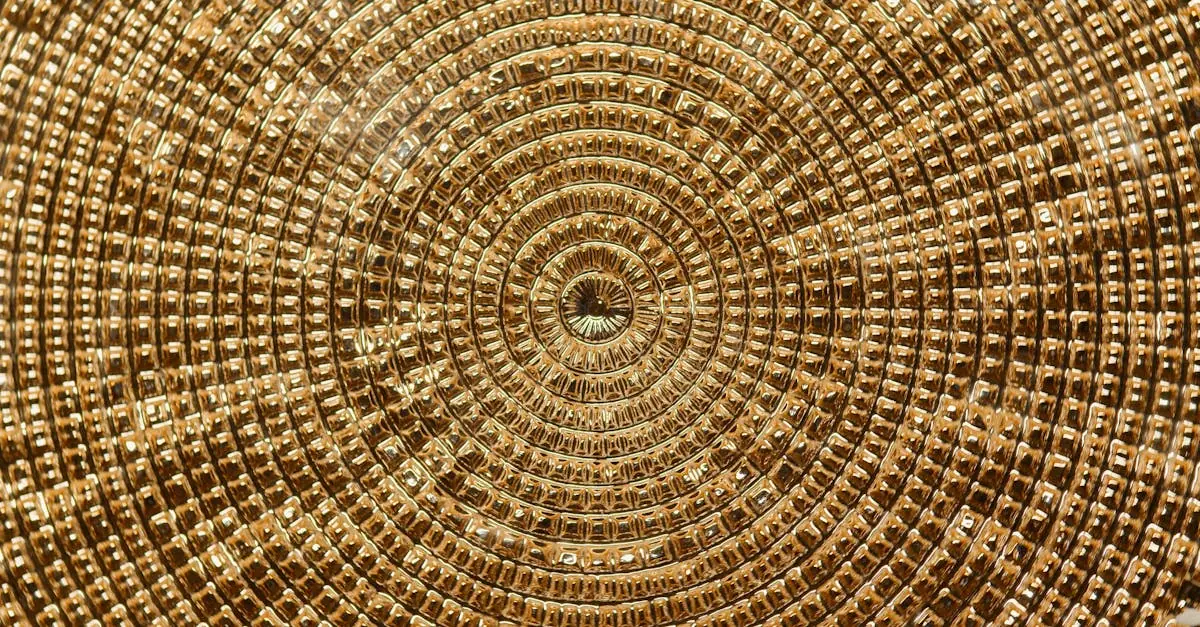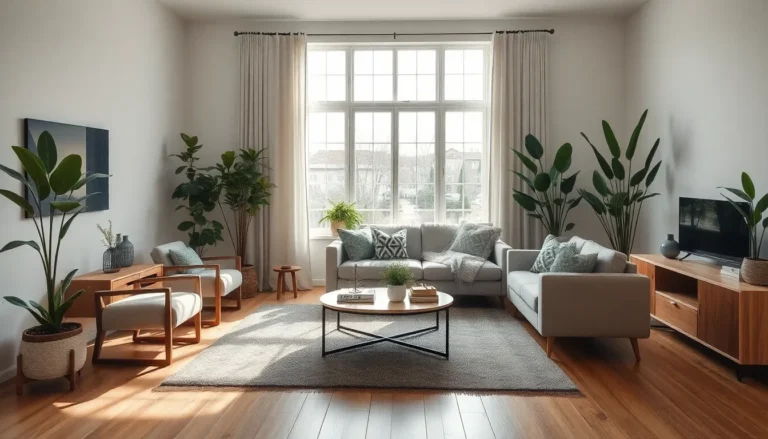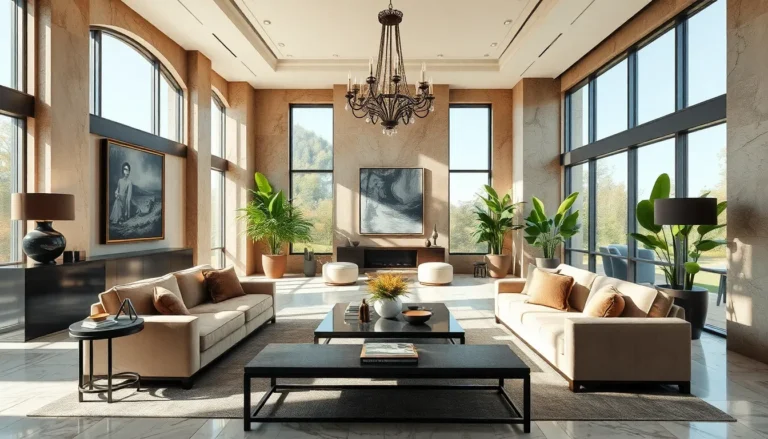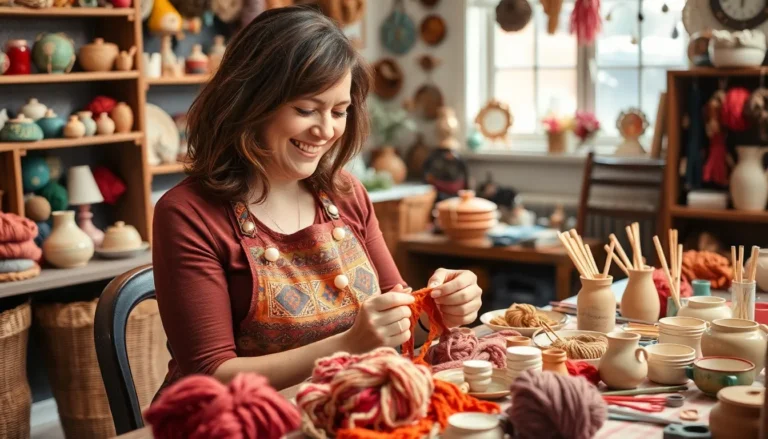Table of Contents
ToggleTransforming a dull wall into a captivating masterpiece is easier than ever with textured wall paint. Gone are the days of flat, lifeless surfaces. With a splash of creativity and a brush in hand, anyone can add dimension and character to their space. Imagine your walls telling a story, inviting compliments, and maybe even a little envy from friends.
Textured wall paint isn’t just about looks; it’s a clever way to hide imperfections and add depth without breaking the bank. From subtle finishes to bold patterns, there’s a style for every personality. So why settle for boring when you can embrace the extraordinary? Dive into the world of textured wall paint and discover how a little texture can go a long way in elevating your home decor game.
Overview Of Textured Wall Paint
Textured wall paint enhances aesthetics and functionality in interior spaces. It adds depth and character to walls, transforming ordinary surfaces into eye-catching focal points. Various styles cater to different preferences, from subtle textures that provide gentle interest to bold patterns that make a statement.
One key advantage lies in its ability to conceal imperfections in drywall or previous paint jobs. This feature reduces the need for extensive wall repairs before painting. Many choose textured paint for its cost-effectiveness, as it offers significant visual impact without the expense of wallpaper or elaborate wall treatments.
Application methods vary, allowing for personal preferences. Rollers and brushes can create distinct textures, ranging from stucco-like finishes to smooth, matte looks. The materials used in textured paints, such as acrylics or vinyl, enhance durability and washability, making maintenance straightforward.
Eco-friendly options exist, ensuring health-conscious individuals can find suitable products. Low-VOC and no-VOC textured paints minimize environmental impact while providing similar performance to traditional paints. Custom colors enable homeowners to match their unique style, ensuring every room reflects personal taste.
In many cases, textured wall paint helps in creating a cohesive design theme throughout the home. It pairs well with various design elements, from modern minimalist to rustic charm. Selecting the right texture can elevate the overall atmosphere, making spaces feel inviting and stylish.
Benefits Of Textured Wall Paint
Textured wall paint offers significant advantages, enhancing both the visual appeal and functionality of interior spaces.
Enhanced Aesthetics
Textured wall paint elevates room design, transforming standard walls into artistic backdrops. It creates depth and visual interest through various styles, such as stucco, sand, and knockdown. Bright colors or subtle hues complement multiple decor styles, allowing for customization. Shadows and light enhance textures, making spaces feel dynamic. Homeowners enjoy versatile options for both modern and traditional interiors. Distinct textures can act as focal points, drawing attention and admiration. Overall, textured paint adds a unique character that flat paint cannot achieve.
Concealing Imperfections
Textured wall paint excels at hiding surface flaws, making it a practical choice for older homes. Cracks, dents, and uneven finishes become less noticeable with the right texture applied. Such paint reduces the need for extensive repairs, saving both time and money. Effortless maintenance remains a key benefit as well; textured surfaces often hide dirt and stains more effectively. Homeowners appreciate the longevity and durability of textured finishes. This paint option enhances the overall visual integrity of walls, ensuring a polished look without extensive prep work.
Types Of Textured Wall Paint
Textured wall paint comes in several styles, each offering unique effects and applications.
Spray Textured Paint
Spray textured paint provides a quick and even finish. It uses a spray gun to apply paint, creating granular or stippled effects. This method works well for larger areas, as it covers surfaces rapidly. Different textures, such as knockdown or popcorn, enhance visual interest. Homeowners appreciate the ease of application, resulting in significant time savings. For best results, proper surface preparation is essential to ensure adherence. Cleanup involves rinsing the spray equipment, ensuring minimal effort.
Roller Textured Paint
Roller textured paint uses a special roller with a raised pattern to create designs on walls. This technique produces consistent patterns like ridges or waves, offering a smooth application process. Heavier paint helps achieve thicker textures, while lighter materials create subtle variations. Roller application suits smaller spaces, allowing for precise control. It enhances the depth of color and texture simultaneously. Clean-up involves washing the roller and tray, making it a manageable project.
Trowel Textured Paint
Trowel textured paint employs a trowel or putty knife to apply thick layers of paint to walls. This method allows for a high level of customization in texture design, ranging from earthy to sculptural styles. Artisans can create intricate patterns, giving walls a distinct appeal. Surface preparation remains crucial, as imperfections beneath the paint may become visible. Many prefer this technique for high-impact statements in living areas. Cleanup consists of washing tools after application to maintain usability.
Application Techniques
Applying textured wall paint requires careful planning and execution to achieve optimal results. Proper preparation sets the stage for a flawless finish that enhances the overall aesthetic.
Preparation Steps
Start by cleaning the wall surface. Remove dust, grease, and flaking paint to ensure strong adhesion. Next, patch any cracks or holes. Using sandpaper, smooth rough areas for a uniform texture. Protect furniture and flooring with drop cloths or plastic sheeting. Before applying paint, use painter’s tape to cover edges and trim. Lastly, if necessary, apply a primer to enhance coverage, particularly on porous or dark surfaces. This preparation ensures that the paint adheres well and the final result looks professional.
Tips For A Smooth Application
Use high-quality tools to ensure an even texture. Select a good roller or sprayer designed for textured paint. Start applying paint from the corner and work towards the center of the wall. Apply paint in sections to maintain a wet edge, preventing visible lines. While working, blend each section into the next to create a seamless look. For best results, maintain consistent pressure and speed during application. Allow adequate drying time before applying additional layers or finishing coats for an optimal finish.
Maintenance And Care
Textured wall paint requires specific maintenance to preserve its appearance and longevity. Regular care ensures walls remain attractive and functional over time.
Cleaning Textured Walls
Cleaning textured walls involves simple techniques. Use a soft-bristle brush or a vacuum with a brush attachment to remove dust and dirt. For spot cleaning, employ a damp cloth with mild soap. Avoid abrasive cleaners that could damage the texture. Rinse with clean water to prevent residue buildup. Staying consistent with cleaning every few months helps maintain the paint’s integrity and visual appeal.
Repairing Damage
Addressing damage on textured walls demands prompt action. For small nicks and scratches, apply a matching textured filler with a putty knife. Smooth it out to blend with the surrounding area. Allow the repair to dry completely before painting over it with a color-matched paint. In cases of larger damages, consider reapplying a small section of textured paint using the original method for consistency. Acting quickly prevents further deterioration and keeps walls looking pristine.
Textured wall paint offers a unique opportunity to enhance any living space while providing practical benefits. Its ability to conceal imperfections makes it an ideal choice for homeowners looking to refresh older properties. With various application methods and styles available, textured paint allows for creativity and personalization in home decor.
Regular maintenance ensures that the stunning visual impact of textured walls remains intact. By following simple care tips, homeowners can keep their walls looking fresh and inviting. Embracing textured wall paint not only transforms interiors but also reflects individual style, making it a valuable addition to any home design project.







